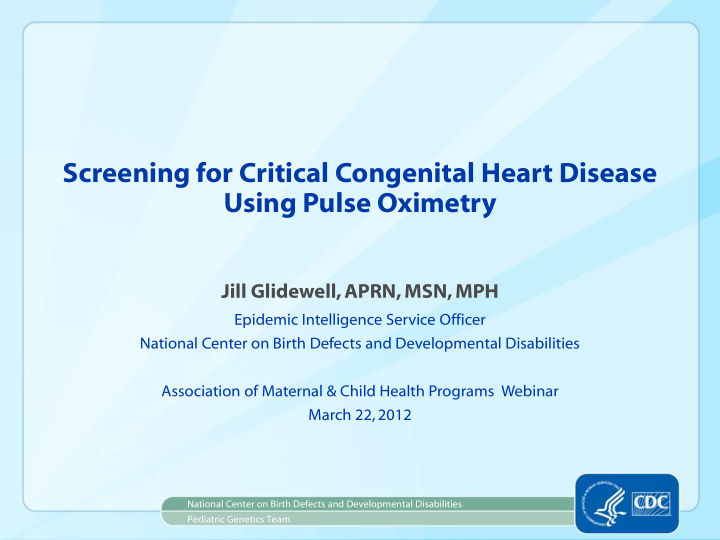



Screening for Critical Congenital Heart Disease Using Pulse Oximetry Jill Glidewell, APRN, MSN, MPH Epidemic Intelligence Service Officer National Center on Birth Defects and Developmental Disabilities Association of Maternal & Child Health Programs Webinar March 22, 2012 National Center on Birth Defects and Developmental Disabilities Pediatric Genetics Team
Outline Federal role in implementation of CCHD Screening State activities with CCHD Screening Survey of birth defects surveillance programs
Federal Activities Screening Standards and Infrastructure : HRSA to guide the development of screening standards/infrastructure Education and Training : HRSA to fund the development of appropriate education/training materials FDA to provide guidance to industry and FDA staff on pulse oximeters Research: NIH to determine the screening technology, diagnostic processes, care provided and health outcomes Surveillance : CDC to monitor infant mortality and other health outcomes (clinical utility and program evaluation)
Federal Activities Screening Standards and Infrastructure : HRSA to guide the development of screening standards/infrastructure Education and Training : HRSA to fund the development of appropriate education/training materials FDA to provide guidance to industry and FDA staff on pulse oximeters Research: NIH to determine the screening technology, diagnostic processes, care provided and health outcomes Surveillance : CDC to monitor infant mortality and other health outcomes (clinical utility and program evaluation)
CDC Activities Evaluate state surveillance and tracking National Birth Defects Prevention Network (NBDPN) survey of states Collaboration with New Jersey, Epi-Aid to assess surveillance, tracking Conduct a cost-effectiveness analysis CCHD screening Collaboration with New Jersey, Econ-Aid to assess total cost burden Ongoing evaluation activities Leverage an electronic health record framework NCBDDD working group on EHRs Creating a strategic plan on leveraging EHRs for public health activities, focus on CHD Collaboration with National Library of Medicine
Current as of March 16, 2012
Bills Introduced During 2011-2012 Legislative Sessions (As of February 29, 2012)
Survey of Birth Defects Surveillance Programs To assess the potential role of state birth defects surveillance programs with screening for critical congenital heart disease (CCHD) First distributed in October 2010 by NBDPN Revised in November 2011 following the addition of CCHD to uniform newborn screening panel States were asked to confirm or change responses from 2010
Does your state have a birth defects surveillance program? 50 43 45 40 35 30 25 20 15 8 10 5 0 Yes No NBDPN survey, 2011
Is your state engaged in pulse oximetry screening for CCHD? 35 30 30 25 21 2010 20 2011 15 12 10 10 5 3 1 0 Yes No Don't know NBDPN survey, 2010 & 2011
If state is engaged in screening activities, is the screening: 10 9 9 8 7 6 5 4 4 3 2 1 1 1 0 Universal, statewide Regional Hospital-based Other NBDPN survey, 2011
If your state is engaged in screening activities, what components are included? 6 5 5 4 4 3 3 2 1 0 Screening only Screening and followup Other of positive screens NBDPN survey, 2011
If your state adopts NBS for CCHD, how could the birth defects surveillance program assist with the confirmed cases of CCHD? Possible Options for Assistance Number of States Link children identified by screening to 16 support services Report on healthcare utilization by affected 13 children Report on support services utilization by 7 affected children Report on enrollment of affected children into 1 special education services Other 8 NBDPN survey, 2010 & 2011
How could the birth defects surveillance program assist with evaluation of CCHD newborn screening? Possible Options for Assistance Number of States Evaluate mortality associated with CCHD 28 Evaluate morbidities associated with CCHD 16 Evaluate interventions associated with CCHD 11 Compare outcomes of children with CCHD 14 Evaluate all true and false positive screens 13 Evaluate false negative screens 13 Assist with economic evaluation of screening 8 Other 8 NBDPN survey, 2010 & 2011
What is the working relationship between your state’s birth defects surveillance program and newborn screening program? Relationship Number of States Organizationally located together 11 Contained within the same bureau/program 15 Physically located in the same building 14 Currently share same database/data system 8 None/No working relationship 5 Other 10 NBDPN survey, 2010 & 2011
What are the likely barriers in your state to your program’s involvement with newborn screening for CCHD? 35 29 30 27 25 19 19 20 15 10 8 5 0 Lack of Inadequate staffing Insufficient funds Information Other legislative/regulatory technology/ data language/authority linkage needs NBDPN survey, 2010 & 2011
Summary Many state birth defects surveillance programs have the data needed to evaluate implementation of CCHD screening Opportunity for collaboration between state newborn screening and birth defects programs Barriers to involvement in CCHD screening exist in many states regardless of legislative activity
Resources CDC, National Center on Birth Defects and Developmental Disabilities: Screening for Critical Congenital Heart Defects http://www.cdc.gov/ncbddd/pediatricgenetics/cchdscreening.Html National Birth Defects Prevention Network http://www.nbdpn.org/ Congenital Heart Public Health Consortium http://chphc.org/hostedsites/Pages/default.aspx Toolkit for Providers: Children’s National Medical Center Congenital Heart Screening Program http://www.childrensnational.org/PulseOx/HealthCareProvidersReso urces.aspx
Acknowledgements CDC/NCBDDD Peggy Honein NJDHSS Coleen Boyle Lori Garg Jim Kucik Leslie Beres-Sochka Cynthia Cassell Cara Mai Mary Knapp Tiffany Colarusso Cindy Moore Kim Van Naarden-Braun Krista Crider Richard Olney AMCHP Ridgely Fisk Green Matt Oster Kate Howe Suzanne Gilboa Cora Peterson NY State DoH Scott Grosse Kim Smith Chris Kus Cindy Hinton NBDPN Glenn Copeland All state BD & NBS Programs
Thank You For more information please contact Centers for Disease Control and Prevention 1600 Clifton Road NE, Atlanta, GA 30333 Telephone, 1-800-CDC-INFO (232-4636)/TTY: 1-888-232-6348 E-mail: cdcinfo@cdc.gov Web: www.cdc.gov The findings and conclusions in this presentation are those of the authors and do not necessarily represent the official position of the Centers for Disease Control and Prevention. National Center on Birth Defects and Developmental Disabilities
Recommend
More recommend